University Business and Corporation Law Assignment: Case Analysis
VerifiedAdded on 2021/04/19
|7
|1441
|97
Homework Assignment
AI Summary
This assignment analyzes four distinct legal issues within a business and corporation law context. The first issue addresses Emma's liability for providing incorrect information leading to damages, referencing the Law of Torts and negligence principles. The second issue examines Richard's obligation to pay increased rent, drawing on contract law and agreement breaches. The third issue concerns Tom's liability for failing to purchase a car, focusing on contract formation and breach. The fourth issue explores Richard's liability for breaching an agreement with Martin, even without formal consideration, again referencing contract law. Each issue is analyzed with relevant laws, applications to the scenarios, and conclusions, supported by references to legal cases and scholarly articles. The assignment covers key aspects of contract law, including offer and acceptance, consideration, and the duty of care, illustrating how these principles apply to real-world business situations.
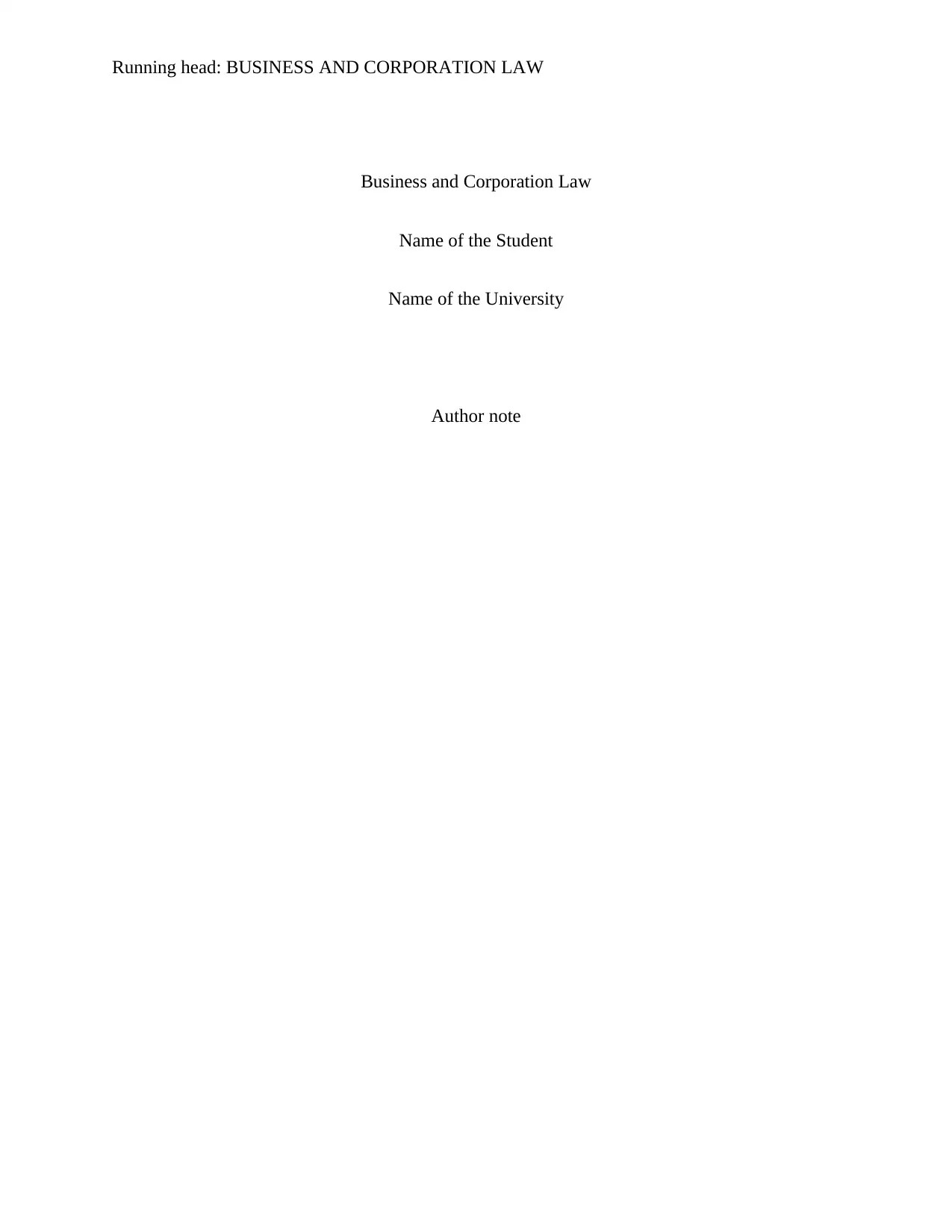
Running head: BUSINESS AND CORPORATION LAW
Business and Corporation Law
Name of the Student
Name of the University
Author note
Business and Corporation Law
Name of the Student
Name of the University
Author note
Paraphrase This Document
Need a fresh take? Get an instant paraphrase of this document with our AI Paraphraser
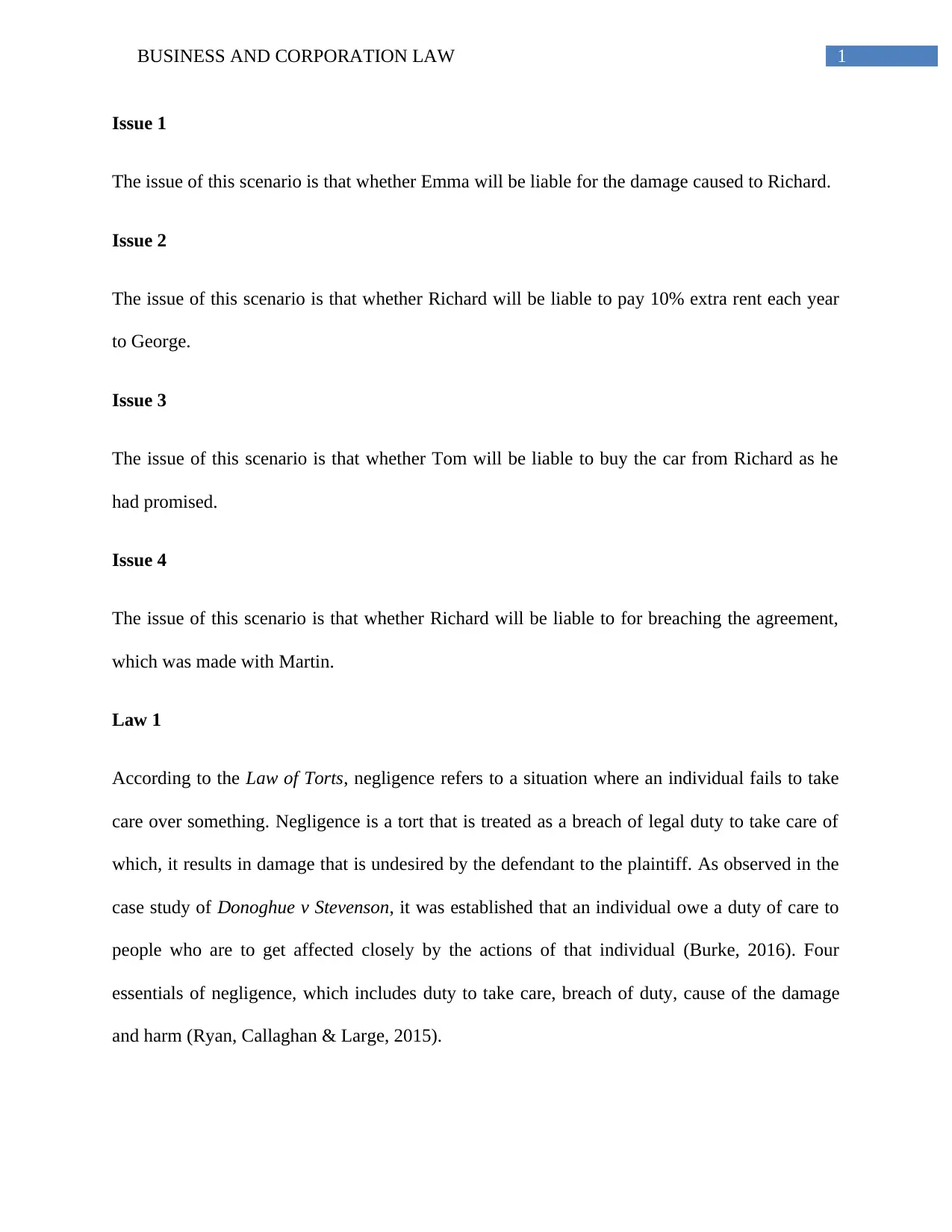
1BUSINESS AND CORPORATION LAW
Issue 1
The issue of this scenario is that whether Emma will be liable for the damage caused to Richard.
Issue 2
The issue of this scenario is that whether Richard will be liable to pay 10% extra rent each year
to George.
Issue 3
The issue of this scenario is that whether Tom will be liable to buy the car from Richard as he
had promised.
Issue 4
The issue of this scenario is that whether Richard will be liable to for breaching the agreement,
which was made with Martin.
Law 1
According to the Law of Torts, negligence refers to a situation where an individual fails to take
care over something. Negligence is a tort that is treated as a breach of legal duty to take care of
which, it results in damage that is undesired by the defendant to the plaintiff. As observed in the
case study of Donoghue v Stevenson, it was established that an individual owe a duty of care to
people who are to get affected closely by the actions of that individual (Burke, 2016). Four
essentials of negligence, which includes duty to take care, breach of duty, cause of the damage
and harm (Ryan, Callaghan & Large, 2015).
Issue 1
The issue of this scenario is that whether Emma will be liable for the damage caused to Richard.
Issue 2
The issue of this scenario is that whether Richard will be liable to pay 10% extra rent each year
to George.
Issue 3
The issue of this scenario is that whether Tom will be liable to buy the car from Richard as he
had promised.
Issue 4
The issue of this scenario is that whether Richard will be liable to for breaching the agreement,
which was made with Martin.
Law 1
According to the Law of Torts, negligence refers to a situation where an individual fails to take
care over something. Negligence is a tort that is treated as a breach of legal duty to take care of
which, it results in damage that is undesired by the defendant to the plaintiff. As observed in the
case study of Donoghue v Stevenson, it was established that an individual owe a duty of care to
people who are to get affected closely by the actions of that individual (Burke, 2016). Four
essentials of negligence, which includes duty to take care, breach of duty, cause of the damage
and harm (Ryan, Callaghan & Large, 2015).
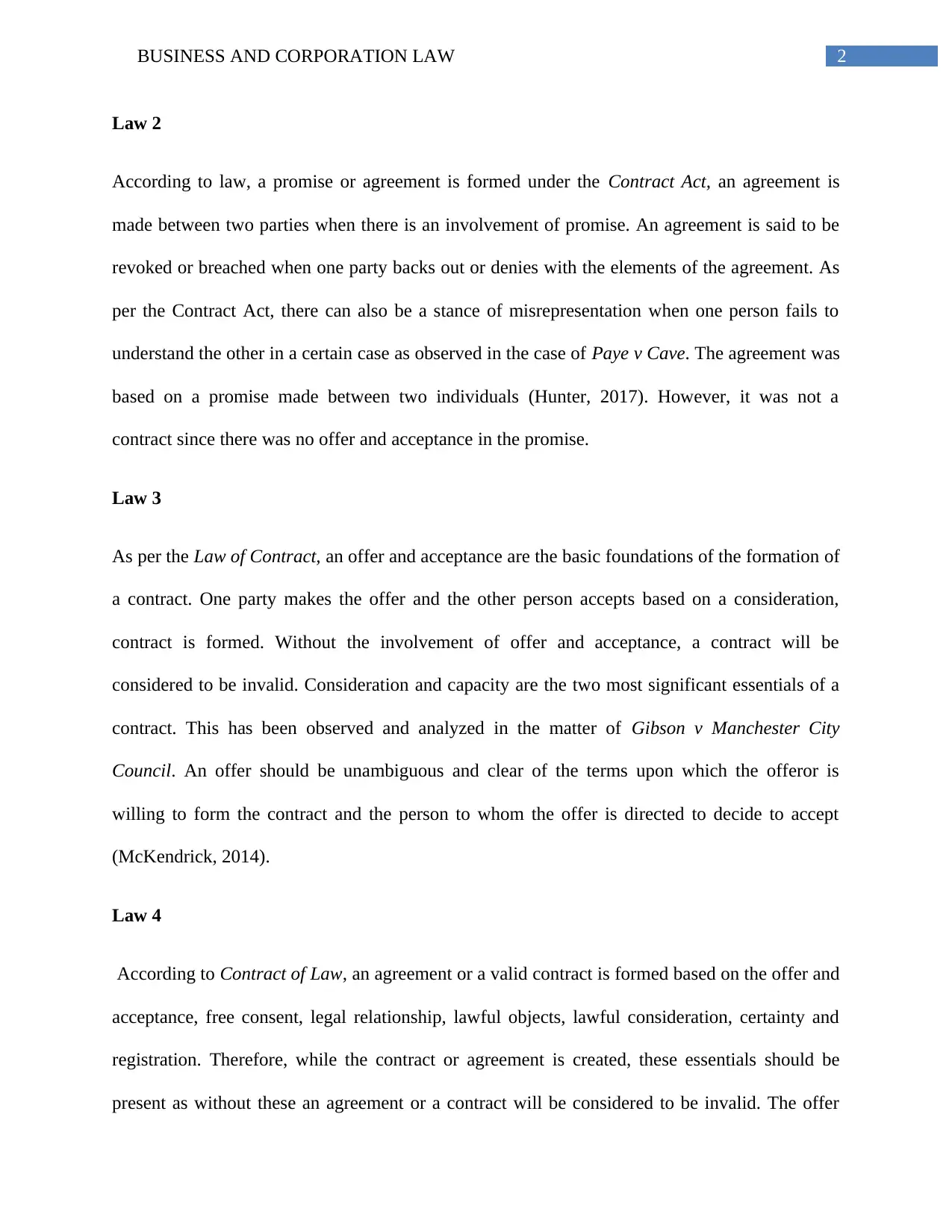
2BUSINESS AND CORPORATION LAW
Law 2
According to law, a promise or agreement is formed under the Contract Act, an agreement is
made between two parties when there is an involvement of promise. An agreement is said to be
revoked or breached when one party backs out or denies with the elements of the agreement. As
per the Contract Act, there can also be a stance of misrepresentation when one person fails to
understand the other in a certain case as observed in the case of Paye v Cave. The agreement was
based on a promise made between two individuals (Hunter, 2017). However, it was not a
contract since there was no offer and acceptance in the promise.
Law 3
As per the Law of Contract, an offer and acceptance are the basic foundations of the formation of
a contract. One party makes the offer and the other person accepts based on a consideration,
contract is formed. Without the involvement of offer and acceptance, a contract will be
considered to be invalid. Consideration and capacity are the two most significant essentials of a
contract. This has been observed and analyzed in the matter of Gibson v Manchester City
Council. An offer should be unambiguous and clear of the terms upon which the offeror is
willing to form the contract and the person to whom the offer is directed to decide to accept
(McKendrick, 2014).
Law 4
According to Contract of Law, an agreement or a valid contract is formed based on the offer and
acceptance, free consent, legal relationship, lawful objects, lawful consideration, certainty and
registration. Therefore, while the contract or agreement is created, these essentials should be
present as without these an agreement or a contract will be considered to be invalid. The offer
Law 2
According to law, a promise or agreement is formed under the Contract Act, an agreement is
made between two parties when there is an involvement of promise. An agreement is said to be
revoked or breached when one party backs out or denies with the elements of the agreement. As
per the Contract Act, there can also be a stance of misrepresentation when one person fails to
understand the other in a certain case as observed in the case of Paye v Cave. The agreement was
based on a promise made between two individuals (Hunter, 2017). However, it was not a
contract since there was no offer and acceptance in the promise.
Law 3
As per the Law of Contract, an offer and acceptance are the basic foundations of the formation of
a contract. One party makes the offer and the other person accepts based on a consideration,
contract is formed. Without the involvement of offer and acceptance, a contract will be
considered to be invalid. Consideration and capacity are the two most significant essentials of a
contract. This has been observed and analyzed in the matter of Gibson v Manchester City
Council. An offer should be unambiguous and clear of the terms upon which the offeror is
willing to form the contract and the person to whom the offer is directed to decide to accept
(McKendrick, 2014).
Law 4
According to Contract of Law, an agreement or a valid contract is formed based on the offer and
acceptance, free consent, legal relationship, lawful objects, lawful consideration, certainty and
registration. Therefore, while the contract or agreement is created, these essentials should be
present as without these an agreement or a contract will be considered to be invalid. The offer
⊘ This is a preview!⊘
Do you want full access?
Subscribe today to unlock all pages.

Trusted by 1+ million students worldwide
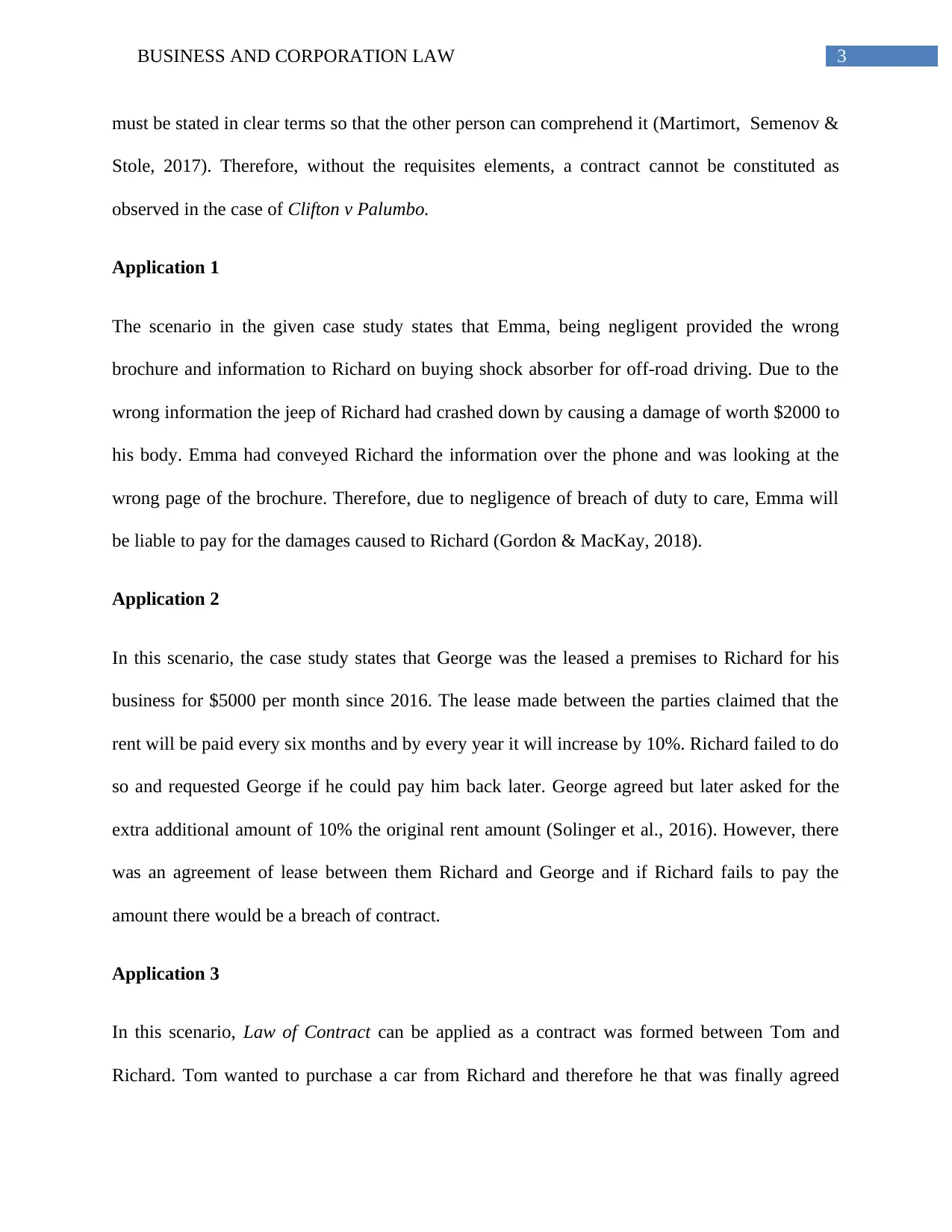
3BUSINESS AND CORPORATION LAW
must be stated in clear terms so that the other person can comprehend it (Martimort, Semenov &
Stole, 2017). Therefore, without the requisites elements, a contract cannot be constituted as
observed in the case of Clifton v Palumbo.
Application 1
The scenario in the given case study states that Emma, being negligent provided the wrong
brochure and information to Richard on buying shock absorber for off-road driving. Due to the
wrong information the jeep of Richard had crashed down by causing a damage of worth $2000 to
his body. Emma had conveyed Richard the information over the phone and was looking at the
wrong page of the brochure. Therefore, due to negligence of breach of duty to care, Emma will
be liable to pay for the damages caused to Richard (Gordon & MacKay, 2018).
Application 2
In this scenario, the case study states that George was the leased a premises to Richard for his
business for $5000 per month since 2016. The lease made between the parties claimed that the
rent will be paid every six months and by every year it will increase by 10%. Richard failed to do
so and requested George if he could pay him back later. George agreed but later asked for the
extra additional amount of 10% the original rent amount (Solinger et al., 2016). However, there
was an agreement of lease between them Richard and George and if Richard fails to pay the
amount there would be a breach of contract.
Application 3
In this scenario, Law of Contract can be applied as a contract was formed between Tom and
Richard. Tom wanted to purchase a car from Richard and therefore he that was finally agreed
must be stated in clear terms so that the other person can comprehend it (Martimort, Semenov &
Stole, 2017). Therefore, without the requisites elements, a contract cannot be constituted as
observed in the case of Clifton v Palumbo.
Application 1
The scenario in the given case study states that Emma, being negligent provided the wrong
brochure and information to Richard on buying shock absorber for off-road driving. Due to the
wrong information the jeep of Richard had crashed down by causing a damage of worth $2000 to
his body. Emma had conveyed Richard the information over the phone and was looking at the
wrong page of the brochure. Therefore, due to negligence of breach of duty to care, Emma will
be liable to pay for the damages caused to Richard (Gordon & MacKay, 2018).
Application 2
In this scenario, the case study states that George was the leased a premises to Richard for his
business for $5000 per month since 2016. The lease made between the parties claimed that the
rent will be paid every six months and by every year it will increase by 10%. Richard failed to do
so and requested George if he could pay him back later. George agreed but later asked for the
extra additional amount of 10% the original rent amount (Solinger et al., 2016). However, there
was an agreement of lease between them Richard and George and if Richard fails to pay the
amount there would be a breach of contract.
Application 3
In this scenario, Law of Contract can be applied as a contract was formed between Tom and
Richard. Tom wanted to purchase a car from Richard and therefore he that was finally agreed
Paraphrase This Document
Need a fresh take? Get an instant paraphrase of this document with our AI Paraphraser
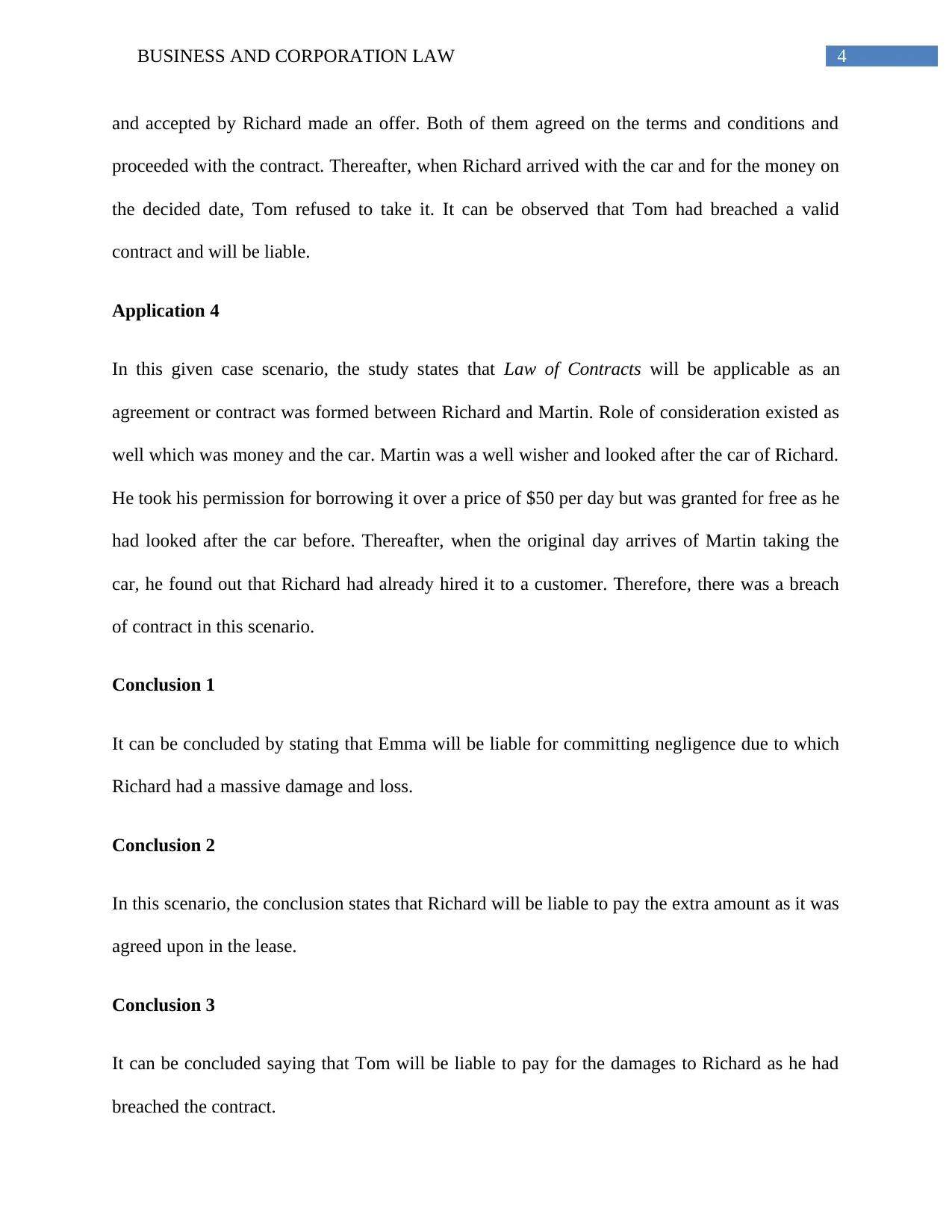
4BUSINESS AND CORPORATION LAW
and accepted by Richard made an offer. Both of them agreed on the terms and conditions and
proceeded with the contract. Thereafter, when Richard arrived with the car and for the money on
the decided date, Tom refused to take it. It can be observed that Tom had breached a valid
contract and will be liable.
Application 4
In this given case scenario, the study states that Law of Contracts will be applicable as an
agreement or contract was formed between Richard and Martin. Role of consideration existed as
well which was money and the car. Martin was a well wisher and looked after the car of Richard.
He took his permission for borrowing it over a price of $50 per day but was granted for free as he
had looked after the car before. Thereafter, when the original day arrives of Martin taking the
car, he found out that Richard had already hired it to a customer. Therefore, there was a breach
of contract in this scenario.
Conclusion 1
It can be concluded by stating that Emma will be liable for committing negligence due to which
Richard had a massive damage and loss.
Conclusion 2
In this scenario, the conclusion states that Richard will be liable to pay the extra amount as it was
agreed upon in the lease.
Conclusion 3
It can be concluded saying that Tom will be liable to pay for the damages to Richard as he had
breached the contract.
and accepted by Richard made an offer. Both of them agreed on the terms and conditions and
proceeded with the contract. Thereafter, when Richard arrived with the car and for the money on
the decided date, Tom refused to take it. It can be observed that Tom had breached a valid
contract and will be liable.
Application 4
In this given case scenario, the study states that Law of Contracts will be applicable as an
agreement or contract was formed between Richard and Martin. Role of consideration existed as
well which was money and the car. Martin was a well wisher and looked after the car of Richard.
He took his permission for borrowing it over a price of $50 per day but was granted for free as he
had looked after the car before. Thereafter, when the original day arrives of Martin taking the
car, he found out that Richard had already hired it to a customer. Therefore, there was a breach
of contract in this scenario.
Conclusion 1
It can be concluded by stating that Emma will be liable for committing negligence due to which
Richard had a massive damage and loss.
Conclusion 2
In this scenario, the conclusion states that Richard will be liable to pay the extra amount as it was
agreed upon in the lease.
Conclusion 3
It can be concluded saying that Tom will be liable to pay for the damages to Richard as he had
breached the contract.
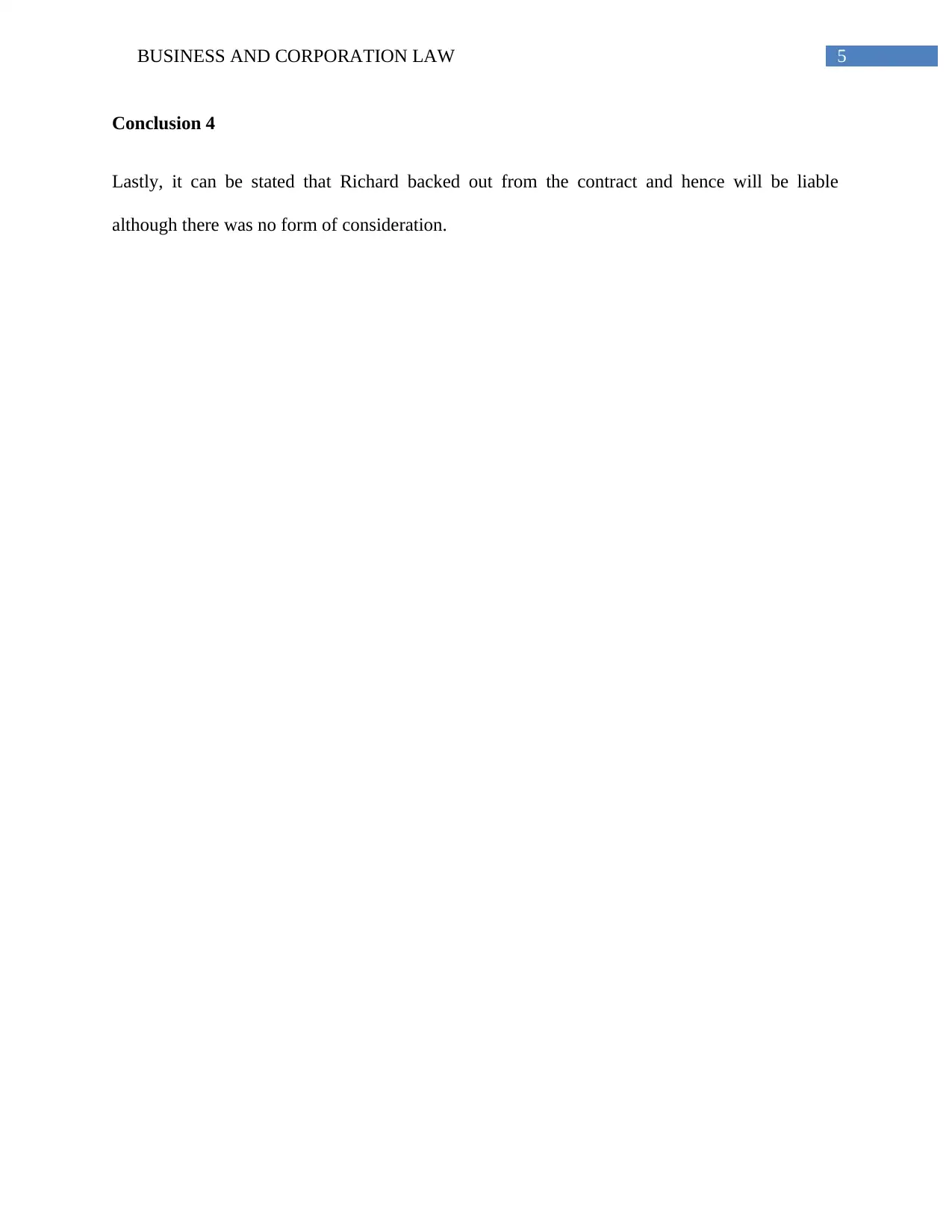
5BUSINESS AND CORPORATION LAW
Conclusion 4
Lastly, it can be stated that Richard backed out from the contract and hence will be liable
although there was no form of consideration.
Conclusion 4
Lastly, it can be stated that Richard backed out from the contract and hence will be liable
although there was no form of consideration.
⊘ This is a preview!⊘
Do you want full access?
Subscribe today to unlock all pages.

Trusted by 1+ million students worldwide
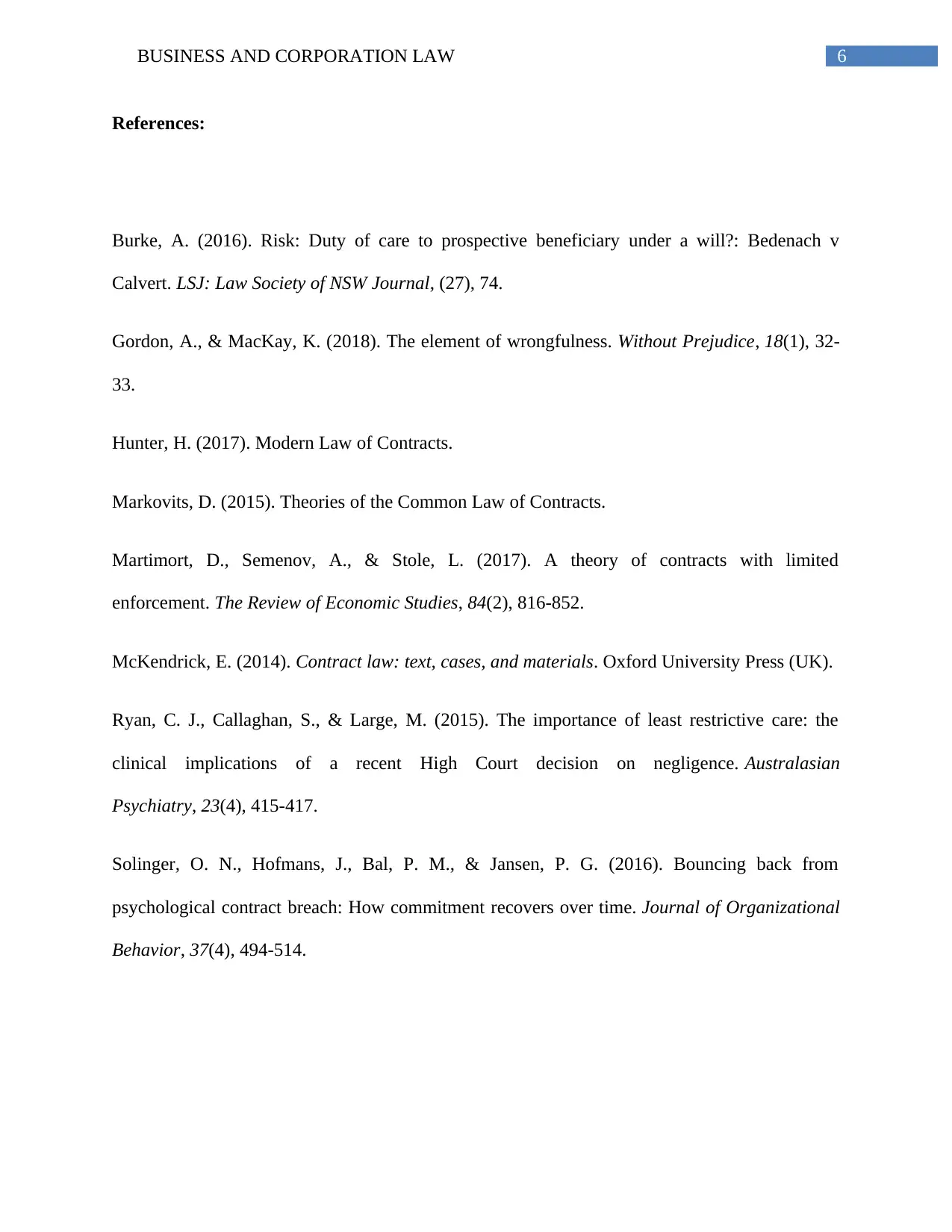
6BUSINESS AND CORPORATION LAW
References:
Burke, A. (2016). Risk: Duty of care to prospective beneficiary under a will?: Bedenach v
Calvert. LSJ: Law Society of NSW Journal, (27), 74.
Gordon, A., & MacKay, K. (2018). The element of wrongfulness. Without Prejudice, 18(1), 32-
33.
Hunter, H. (2017). Modern Law of Contracts.
Markovits, D. (2015). Theories of the Common Law of Contracts.
Martimort, D., Semenov, A., & Stole, L. (2017). A theory of contracts with limited
enforcement. The Review of Economic Studies, 84(2), 816-852.
McKendrick, E. (2014). Contract law: text, cases, and materials. Oxford University Press (UK).
Ryan, C. J., Callaghan, S., & Large, M. (2015). The importance of least restrictive care: the
clinical implications of a recent High Court decision on negligence. Australasian
Psychiatry, 23(4), 415-417.
Solinger, O. N., Hofmans, J., Bal, P. M., & Jansen, P. G. (2016). Bouncing back from
psychological contract breach: How commitment recovers over time. Journal of Organizational
Behavior, 37(4), 494-514.
References:
Burke, A. (2016). Risk: Duty of care to prospective beneficiary under a will?: Bedenach v
Calvert. LSJ: Law Society of NSW Journal, (27), 74.
Gordon, A., & MacKay, K. (2018). The element of wrongfulness. Without Prejudice, 18(1), 32-
33.
Hunter, H. (2017). Modern Law of Contracts.
Markovits, D. (2015). Theories of the Common Law of Contracts.
Martimort, D., Semenov, A., & Stole, L. (2017). A theory of contracts with limited
enforcement. The Review of Economic Studies, 84(2), 816-852.
McKendrick, E. (2014). Contract law: text, cases, and materials. Oxford University Press (UK).
Ryan, C. J., Callaghan, S., & Large, M. (2015). The importance of least restrictive care: the
clinical implications of a recent High Court decision on negligence. Australasian
Psychiatry, 23(4), 415-417.
Solinger, O. N., Hofmans, J., Bal, P. M., & Jansen, P. G. (2016). Bouncing back from
psychological contract breach: How commitment recovers over time. Journal of Organizational
Behavior, 37(4), 494-514.
1 out of 7
Related Documents
Your All-in-One AI-Powered Toolkit for Academic Success.
+13062052269
info@desklib.com
Available 24*7 on WhatsApp / Email
![[object Object]](/_next/static/media/star-bottom.7253800d.svg)
Unlock your academic potential
Copyright © 2020–2025 A2Z Services. All Rights Reserved. Developed and managed by ZUCOL.





